How to make presentations, or why not everything takes off? Part 1
Because of my work and generally for the love of art, and also because I have a great desire to share useful information with others, I often have to make presentations to a respectable public at various, as a rule, IT conferences. Not all of my speeches are successful, something turns out better, something worse. Anyway, in the course of several years of practice, some experience has accumulated that I wanted to share, in connection with which, on April 12, a webinar of the same name was held, the recording of which can be viewed on techdays.ru .
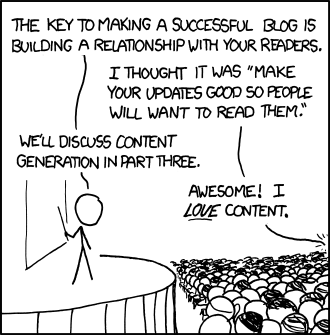
Thinking (not very long), I decided that it would also be nice to share my thoughts in text format: here you can specify, and it is better to decompose on the shelves, and read more conveniently to many.
Much has been written about the preparation and creation of presentations (here I mean both the stage action and the physical, usually digital, object of creativity) - and in the end I will cite several books that I found interesting in the context of the topic under discussion. In my article I will focus on two things:
The first thing to be puzzled sounds like this: “why the hell do I need to do something?” Of course, depending on the context, the wording may change: starting with the banal “why the hell?” Or “do I need it?” And ending with mercantile “What will I get from this?”. And ask yourself a similar question is necessary. Fair.
')
To make it easier to find the answer, here's a little hint: if you are not a notorious idler who just wants to ruffle the language, thereby satisfying his physiological and mental need, then the key word for you is “sharing.”
Sharing is the exchange, sharing, voluntary flow of fluids and information flows from one place to another. As a rule, a satisfying report motivation is the fact that you need or want to share something with someone.
As an option: you need to tell something, because your job duties include drawing up plans and reports, or, say, without defending your thesis, they refuse to give you a diploma. You want to tell something in order to convince someone of something or force the audience to look at things differently.

There is a subtle difference between these two questions ( “why?” And “so what?” ). The first is more likely to be about introductory, encouraging and commitment factors ( “to share because ...” ), the second is more likely to motivate and project for the future ( “to share, to ...” ). In practice, both are often relevant, however, the prevalence of one or the other also turns out to be important, since it can predetermine the format of the speech and the restrictions imposed.

For example, a report at a scientific conference or the defense of a thesis, as a rule, presupposes a rather strict presentation format and the corresponding structure of the report and presentation, starting with the statement of the problem and ending with conclusions and further plans. A presentation to investors with a presentation on a given pattern as a bureaucratic procedure can also involve very specific blocks in the story, usually without kittens and other pranks.
On the other hand, if you share your experience in an informal circle of close friends or speak to colleagues at an industrial IT conference, where you can take liberties or, as they say, you need to work with your audience, then your space for maneuvers will significantly expand. This may be just a conversation with sketches on napkins, and waving hands without slides. And then sometimes you can pobezobraznichat a little, of course, in the framework of decency :)
Therefore, I repeat, in preparing for the report, it is important to answer two questions for yourself: why do you need to share information and what do you want to achieve with this? In principle, it is possible to think about them within the framework of a dichotomy: what will you lose, leaving the intimate with you, and what will you gain by bringing the light of thought to the masses?
Now that you know the answers to both questions, you are ready to formulate the purpose of your speech. In my opinion, such a goal must necessarily contain exhaust - some result projected onto the future of your listeners.

Imagine that the straight line in the center in the picture above is a segment of your life lines. At some point (left point) you tell your report: here your life line intersects with the lines of all your listeners. Next, the presentation will end and your lines will scatter in different directions.
The goal that you formulate for your presentation should relate to how the life lines of the audience or your own will behave in the future. For example, with your performance you can provoke their intersections - be it sales, joint projects, other events or just new useful contacts to which you subscribe on Twitter :) With someone from the audience, perhaps
You will never again directly intersect in your life, but your performance may affect their behaviors, ways of thinking and attitudes towards certain objects and circumstances - for example, the company's image or events in society. Or, another useful exhaust: your own line can change - as a result of feedback during or after the report.
Specifying changes in the future of your or external life lines is the goal of your performance.

A useful model for formulating a goal is finding an answer in the form of 5W + H: who, what, when, where, why and how. Who are you going to influence? What do you want to change in their lines? When and where should these changes occur? Why will your “who” change their lines and how exactly will they do it?
Of course, in practice, this may be too complicated an exercise (do you probably already have itching for a long time and opened PowerPoint with the first slide?). Therefore, do not be too zealous in the casuistry of answers to strange questions. The simple “I want to share my experience so that the audience does not make my mistakes and treat our company better, thinking of it as a progressive IT company” - already sounds quite convincing.
With the goal in mind, it's time to move on to preparing the presentation. Hm I think it's time to close your PowerPoint and put it off for a few days. Presentation preparation is a long and painful process that can drag on for days and even weeks. Of course, if you have so much time. In practice, it also happens that you need to make a presentation “tomorrow”, then this whole process is reduced to several hours, which is not very good, unless you know in advance what exactly you will tell, to whom and why.
It must be said that the latter is a completely traditional scenario in the life of an evangelist, who needs to convey the same idea to various similar audiences. In such situations, as a rule, it is enough to refresh the memory and brush the presentation, updating the individual slides and updating the information, taking into account the context. As a rule, this means that the preparatory work of serial performances was carried out earlier - and it is not much different from all that I will discuss next.
So, you need to prepare a unique or serial performance. What to do? Get ready!
First of all, you need to immerse yourself in the subject of the planned speech, to boil the topic, to speculate on various related topics, to communicate with colleagues, to gather information, to ... do something.
Distract, jump freely on related topics, look for parallels.
Your task is to give a seed to your brain, to induce it to start thinking about the performance and what exactly you will tell.
From time to time it is important to add spices to the soup and firewood to the fire. Look for tasty details, look at potentially interesting materials, continuing to “pump up” your brain with the theme of the speech. This all strengthens the connections between your neurons and allows the brain to “see” the space for performance more clearly and clearly: both the whole picture and individual bright strokes of the future history.
While you are shoveling mountains of information or just studying something, perhaps related to your topic, but, by the way, not necessarily - take notes, write down everything that may come in handy later.
For example, when I was preparing to speak at the Toaster conference with a story about the evolution of the web, it turned out that in parallel I read several books about the evolution of living nature (in particular, Parasites. The Secret World by Karl Zimmer ), which in general well intersected with the theme of the planned report. The more I dived in both directions, the more I saw interesting analogies that could be drawn between the evolution of various creatures and the evolution of the web.
All such interesting things and goodies were recorded in a notebook and bookmarked in the book:
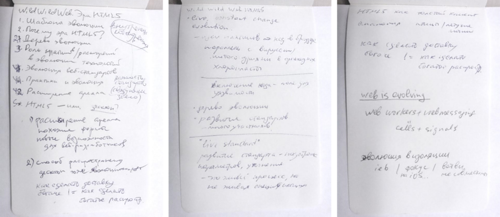
Later, some finds were successfully incorporated into the report:
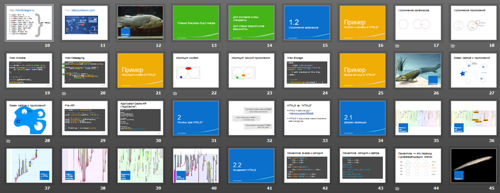
At this stage, it is also important to be aware of when the cooking process should end and it will be time to proceed to the next steps. If you have time, you can stew. If there are a few days left (before the performance, sending slides or any other important benchmark), you need to round out.
The next important step is to start speaking on the topic of your presentation, to pronounce both individual pieces, and try to tell all that you want to convey to the audience. And the key task is not to learn how to perform, for example, doing this exercise in front of a mirror, but to clothe everything that is spinning in your head in a verbal form. To line up verbally logical connections, transitions, questions and appeals to the audience.
Speak
Do it yourself alone. Discuss individual details with colleagues, friends, acquaintances. Make your brain think on the subject of your speech. The more you do it, the freer will be the speech and the flow of thought and, by the way, the easier it will be for you to answer the questions of the audience. Strengthen the connections between the neurons of your brain :)
The important point in "speaking" is that, going through this procedure, you can see and hear the problem points in practice (your own experience):
Mark all such moments for yourself. Simplify speech and articulate thoughts more clearly.
Now that the structure of the story has more or less formed in your head, try to fix it. I usually use simple lists or mindmaps, or other schematic compositions. As a carrier, you can use a regular notebook or a sheet of paper, and a whiteboard, and just any application with the appropriate functionality that will not distract you from additional actions.
For example, when I was preparing to conduct a master class in design for Windows Phone at some point, the following list appeared in my notebook:

It is important to note the key topics, sort, prioritize, arrange the order of presentation and ... estimate timing. In the example above, I had 3.5 hours for a master class, which could conditionally be divided into 21 slots for 10 minutes (3.5 hours = 210 minutes), respectively, it was necessary to leave about 21 mini-topics.
In the end, this also affected the final presentation accompanying the event:
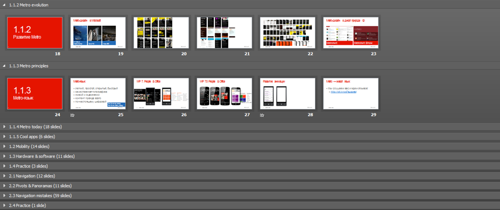
Another example: when I was preparing for a report on UserExperience'11 , having a fragmentary picture in my head (including due to the fact that I had previously had to give presentations and write articles on similar topics), I wrote down in a notebook key topics that fairly quickly transformed into the 5A principle (Accessible, Adaptive, Agile, Async, Attractive):
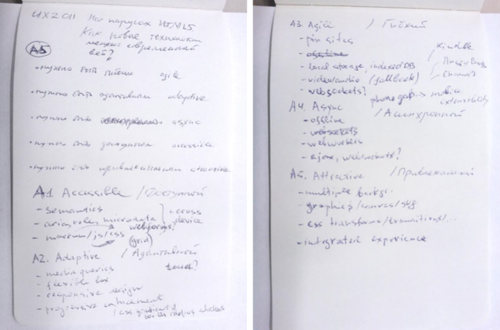
At subsequent stages, it remained to translate this into a presentation and make a presentation:
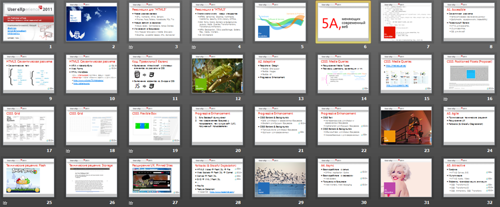
And here is how the intellect map of this article and the corresponding webinar looked like:
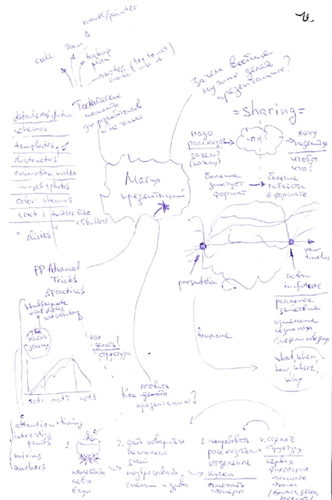
So: speak and draw.
Fixation and development are interrelated and mutually supportive processes. It is often difficult to immediately tell the entire content of the report, or at least fully present it in my head. In this sense, fixing on paper (or other media) is an excellent tool for developing thought, as it allows you to visually display the key points of the story. Such reference phrases and concepts also allow you to keep the focus and do not distract very much from the main presentation.
Therefore, in practice, you can move iteratively: think, talk on the topic of the report, fix. Try again to talk with regard to the fixed plan - see what happens. Further expand, deepen, make adjustments or rewrite everything completely from scratch. Repeat the cycle until desired readiness.
From time to time, you can also go back to the second step: be distracted for a while, broaden your horizons, look for additional details and allow the brain to continue to think about the topic in a passive mode.
Moving on!
If you were previously interested in the theory (recommendations) for creating presentations, you probably met with this scheme:

Perhaps you met her in some other variation. For example, they could tell you about 5 bullets, the minimum text size, and some other "important" parameters.
My practice shows that all this is useful only in the early stages, when you have little experience, because it allows you to avoid very childish stupidities and mistakes. However, further, if you have a head on your shoulders and you are not devoid of sanity, forget:

The truth is that there is not one single and universal approach for all occasions, suitable for all types of presentations. He simply does not. Therefore, the only thing that can save you is logic, common sense and a sense of taste, supported by experience.
But if there is something, there are some general tips and an understanding of some important aspects of the functioning of the living brain. A little about this and talk.
In any work (book, cinema, opera, etc.) there is a certain composition - the structure of constructing the narration, leading the viewer from the beginning to the end of the story, supporting interest in it and directing to the key ideas that the author wanted to convey (composer, writer director, etc.).
The classic scheme looks like this:
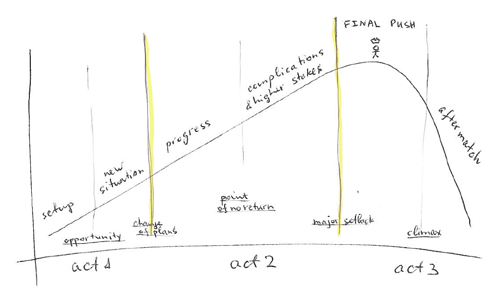
The work can be divided into several acts describing the introduction to the situation, its development up to the key action and the completion of the story. During his journey, the hero goes through a number of important stages, meets challenges, undergoes transformations and eventually wins:
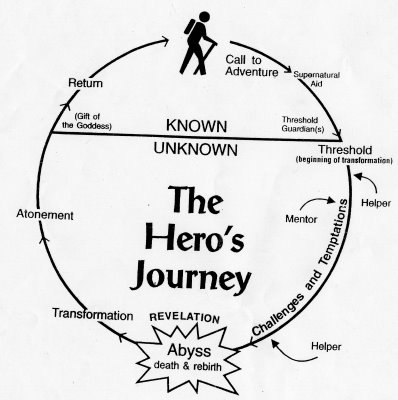
Of course, in practice, the specific pattern of one story will always be different from the pattern of another. There will be a different plot, different timing and different proportions. Somewhere you will share a bitter experience, and somewhere successful solutions. In some cases, throughout the whole story you will tell one specific story, and in others there are many small ones connected by some general idea.
In general, it should be noted that the composition scheme can be viewed in different ways, noting for yourself some important nuances:
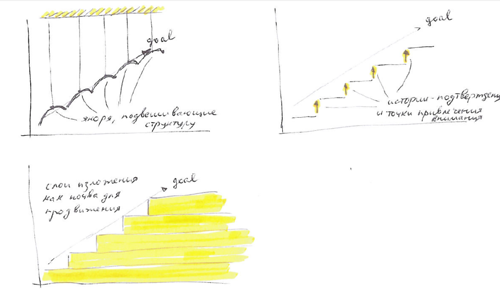
First, it turns out to be important to “hang” the story on some anchors (hooks), which will support the presentation and help the viewer to navigate in what is happening and track the dynamics of development. These are the reference points that set the context. In practice, for example, they can be references-reminders of what was said earlier and what role in this connection is what you are going to say now. It can also be some end-to-end line that permeates your abstract reasoning.
For example, when I gave a talk on Software People about development for Windows 8, such reference points were both a visual division into 5 parts (“5 main points you need to remember”) and the end-to-end theme “who do you need in a team” :
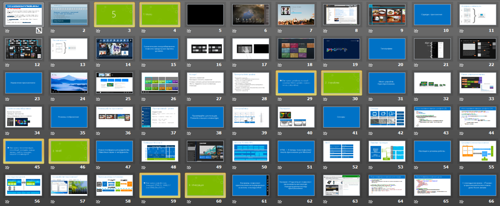
Secondly, in order for the story to develop towards the main idea of your story (the climax of the story), it is necessary to periodically push the viewer up. These can be both supporting stories that support intermediate ideas (for example, in the report on the evolution of the web, which I mentioned above, such stories were analogies with the evolution of living nature), and some points of attention (attractors) that concentrate the interest of viewers before the next leap.
Thirdly, your story may require a certain sequence of presentation, gradually introducing the listener to the course of the matter. You will have a foundation in which you can designate the starting point, the problems that need to be addressed, solutions, as alternatives facing the hero, the choice and resolution of the story, as the culmination. A sort of pyramid in which each subsequent layer is based on the previous one.
Another important point is the interweaving of stories, when you have parallel storylines, or you need to interweave various manifestations of a key topic or different types of content (for example, pictures, videos, demonstrations, etc.) during the story.
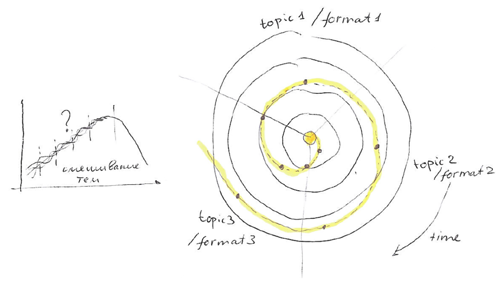
In this case, you can consider the line of your story as a spiral, sequentially passing through all the topics to be interlaced into one story. With this approach, you can both clearly track the development of the story, and make sure that you do not miss the insertion of important related ideas.
For example, preparing a key opening report for HTML5Camp :

we kept such a scheme in our head. The main story revolved around the evolution of the web and the opposition of web applications and native applications, leading to the conclusion that the boundary between these concepts was gradually blurring. The key topics were: web development, web standards and Internet Explorer + development tools.
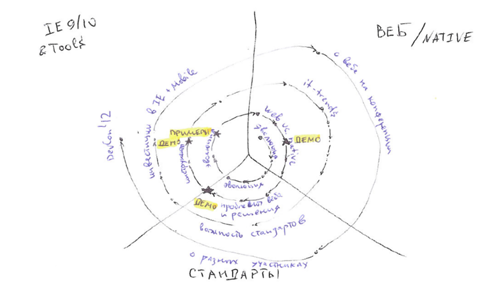
The story began with the evolution of the web, proceeded to the evolution of web standards, then projected onto the Internet Explorer development cycle. The second cycle began with the opposition of the web and native development, proceeded to challenges on the web and ways to solve the problems, projecting on the possibilities supported by IE and the necessary development tools. The third cycle talked about trends in the IT industry and their intersections with the web, proceeded to the importance of standardization and ended with an investment in IE, including in the mobile version. The final fourth cycle described the conference itself: from different topics and different speakers to a reminder of the subsequent DevCon'12 conference.
In general, our keynote had a more or less classical structure, although perhaps this is not immediately apparent from the description above. Gradually moving from one topic to another, including during the demonstrations, the idea was developed that today's web is increasingly catching up on the desktop. The culmination of the story came at the end of the second cycle, when, summing up the search for answers, Alexander Lozhechkin said that web technologies and the browser are not just catching up, but also quite become a platform for native development, hinting at Windows 8. Two short followers followed. cycle.
Your structure may differ from the classics. For example, you can invert the presentation by starting with the result and then talking about how and why you came to it. Whatever your presentation, the most important thing is that the structure was in principle:
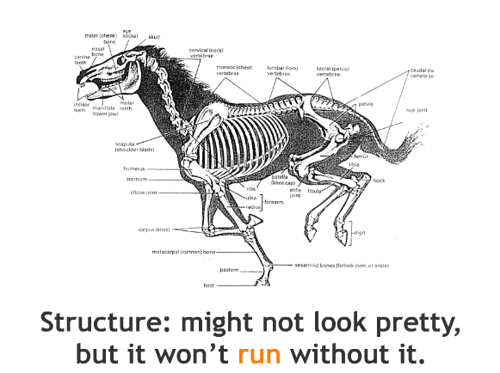
I already mentioned about 10 minutes when I talked about the preparation of a master class on Windows Phone. Perhaps you had time to be puzzled, what is the reason for this figure? So, our brain
gets tired when they push the same thing into him:
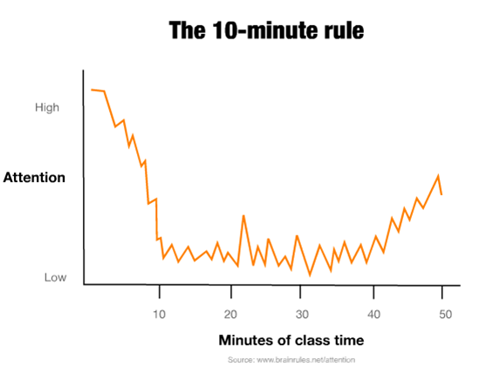
Therefore, from time to time it is necessary to attract the attention of the audience, changing the theme, context, telling stories, moving from words to demonstrations, videos, etc.
Hence the important conclusion: it is necessary not only to build the structure of the story, but also to beat it apart for about 10 minutes or less, each of which will “re-gain” the attention of the audience. Of course, if only your story lasts more than 10 minutes.
As you know, the same thought can be conveyed:
Your idea may turn out to be quite well scalable in time, however, its perception by the audience may begin to suffer simply due to the peculiarities of human perception of information. Therefore, as soon as you jump over the threshold of 10-15 minutes of a monotonous story, your viewer begins to fall asleep - and you have to wake him up. In this sense, do not forget to mark the points where you will focus the attention of the audience, and make sure that they are sufficient to maintain interest.
Finally, before we go (in the second part) to PowerPoint and to make presentations, I cannot but remind the Seth Godin pyramid:
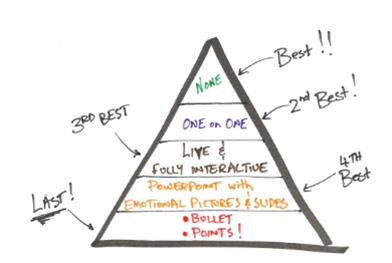
Story is more important than slides. Yes. If you have no single history and no structure, this is bad. Of course, you can simply slack off jokes, but this is probably not what your viewers came for. At best, they will remember a few good jokes. If you talk too much and get scattered, this is bad. No one will remember the main thing. If you forget to attract the attention of the audience, everyone will just fall asleep.

Thinking (not very long), I decided that it would also be nice to share my thoughts in text format: here you can specify, and it is better to decompose on the shelves, and read more conveniently to many.
Much has been written about the preparation and creation of presentations (here I mean both the stage action and the physical, usually digital, object of creativity) - and in the end I will cite several books that I found interesting in the context of the topic under discussion. In my article I will focus on two things:
- preparing the story underlying the presentation and further developing its structure,
- Some aspects and technical nuances that I find useful from a practical point of view when creating a presentation directly (slides).
Why do you need to do presentations?
The first thing to be puzzled sounds like this: “why the hell do I need to do something?” Of course, depending on the context, the wording may change: starting with the banal “why the hell?” Or “do I need it?” And ending with mercantile “What will I get from this?”. And ask yourself a similar question is necessary. Fair.
')
To make it easier to find the answer, here's a little hint: if you are not a notorious idler who just wants to ruffle the language, thereby satisfying his physiological and mental need, then the key word for you is “sharing.”
Sharing is the exchange, sharing, voluntary flow of fluids and information flows from one place to another. As a rule, a satisfying report motivation is the fact that you need or want to share something with someone.
As an option: you need to tell something, because your job duties include drawing up plans and reports, or, say, without defending your thesis, they refuse to give you a diploma. You want to tell something in order to convince someone of something or force the audience to look at things differently.

There is a subtle difference between these two questions ( “why?” And “so what?” ). The first is more likely to be about introductory, encouraging and commitment factors ( “to share because ...” ), the second is more likely to motivate and project for the future ( “to share, to ...” ). In practice, both are often relevant, however, the prevalence of one or the other also turns out to be important, since it can predetermine the format of the speech and the restrictions imposed.

For example, a report at a scientific conference or the defense of a thesis, as a rule, presupposes a rather strict presentation format and the corresponding structure of the report and presentation, starting with the statement of the problem and ending with conclusions and further plans. A presentation to investors with a presentation on a given pattern as a bureaucratic procedure can also involve very specific blocks in the story, usually without kittens and other pranks.
On the other hand, if you share your experience in an informal circle of close friends or speak to colleagues at an industrial IT conference, where you can take liberties or, as they say, you need to work with your audience, then your space for maneuvers will significantly expand. This may be just a conversation with sketches on napkins, and waving hands without slides. And then sometimes you can pobezobraznichat a little, of course, in the framework of decency :)
Therefore, I repeat, in preparing for the report, it is important to answer two questions for yourself: why do you need to share information and what do you want to achieve with this? In principle, it is possible to think about them within the framework of a dichotomy: what will you lose, leaving the intimate with you, and what will you gain by bringing the light of thought to the masses?
About goals
Now that you know the answers to both questions, you are ready to formulate the purpose of your speech. In my opinion, such a goal must necessarily contain exhaust - some result projected onto the future of your listeners.

Imagine that the straight line in the center in the picture above is a segment of your life lines. At some point (left point) you tell your report: here your life line intersects with the lines of all your listeners. Next, the presentation will end and your lines will scatter in different directions.
The goal that you formulate for your presentation should relate to how the life lines of the audience or your own will behave in the future. For example, with your performance you can provoke their intersections - be it sales, joint projects, other events or just new useful contacts to which you subscribe on Twitter :) With someone from the audience, perhaps
You will never again directly intersect in your life, but your performance may affect their behaviors, ways of thinking and attitudes towards certain objects and circumstances - for example, the company's image or events in society. Or, another useful exhaust: your own line can change - as a result of feedback during or after the report.
Specifying changes in the future of your or external life lines is the goal of your performance.

A useful model for formulating a goal is finding an answer in the form of 5W + H: who, what, when, where, why and how. Who are you going to influence? What do you want to change in their lines? When and where should these changes occur? Why will your “who” change their lines and how exactly will they do it?
Of course, in practice, this may be too complicated an exercise (do you probably already have itching for a long time and opened PowerPoint with the first slide?). Therefore, do not be too zealous in the casuistry of answers to strange questions. The simple “I want to share my experience so that the audience does not make my mistakes and treat our company better, thinking of it as a progressive IT company” - already sounds quite convincing.
How to prepare a presentation?
With the goal in mind, it's time to move on to preparing the presentation. Hm I think it's time to close your PowerPoint and put it off for a few days. Presentation preparation is a long and painful process that can drag on for days and even weeks. Of course, if you have so much time. In practice, it also happens that you need to make a presentation “tomorrow”, then this whole process is reduced to several hours, which is not very good, unless you know in advance what exactly you will tell, to whom and why.
It must be said that the latter is a completely traditional scenario in the life of an evangelist, who needs to convey the same idea to various similar audiences. In such situations, as a rule, it is enough to refresh the memory and brush the presentation, updating the individual slides and updating the information, taking into account the context. As a rule, this means that the preparatory work of serial performances was carried out earlier - and it is not much different from all that I will discuss next.
So, you need to prepare a unique or serial performance. What to do? Get ready!
1. Put yourself in the soup
First of all, you need to immerse yourself in the subject of the planned speech, to boil the topic, to speculate on various related topics, to communicate with colleagues, to gather information, to ... do something.
Distract, jump freely on related topics, look for parallels.
Your task is to give a seed to your brain, to induce it to start thinking about the performance and what exactly you will tell.
2. Add spices and firewood
From time to time it is important to add spices to the soup and firewood to the fire. Look for tasty details, look at potentially interesting materials, continuing to “pump up” your brain with the theme of the speech. This all strengthens the connections between your neurons and allows the brain to “see” the space for performance more clearly and clearly: both the whole picture and individual bright strokes of the future history.
While you are shoveling mountains of information or just studying something, perhaps related to your topic, but, by the way, not necessarily - take notes, write down everything that may come in handy later.
For example, when I was preparing to speak at the Toaster conference with a story about the evolution of the web, it turned out that in parallel I read several books about the evolution of living nature (in particular, Parasites. The Secret World by Karl Zimmer ), which in general well intersected with the theme of the planned report. The more I dived in both directions, the more I saw interesting analogies that could be drawn between the evolution of various creatures and the evolution of the web.
All such interesting things and goodies were recorded in a notebook and bookmarked in the book:

Later, some finds were successfully incorporated into the report:

At this stage, it is also important to be aware of when the cooking process should end and it will be time to proceed to the next steps. If you have time, you can stew. If there are a few days left (before the performance, sending slides or any other important benchmark), you need to round out.
3. Speak
The next important step is to start speaking on the topic of your presentation, to pronounce both individual pieces, and try to tell all that you want to convey to the audience. And the key task is not to learn how to perform, for example, doing this exercise in front of a mirror, but to clothe everything that is spinning in your head in a verbal form. To line up verbally logical connections, transitions, questions and appeals to the audience.
Speak
Do it yourself alone. Discuss individual details with colleagues, friends, acquaintances. Make your brain think on the subject of your speech. The more you do it, the freer will be the speech and the flow of thought and, by the way, the easier it will be for you to answer the questions of the audience. Strengthen the connections between the neurons of your brain :)
The important point in "speaking" is that, going through this procedure, you can see and hear the problem points in practice (your own experience):
- blockers in which you do not know what to say or how to formulate a thought;
- looping, in which your thought begins to repeat, and you revolve around the same idea and can not jump further;
- time sinks in which you start to talk a lot and go too deep into details.
Mark all such moments for yourself. Simplify speech and articulate thoughts more clearly.
4. Draw a structure
Now that the structure of the story has more or less formed in your head, try to fix it. I usually use simple lists or mindmaps, or other schematic compositions. As a carrier, you can use a regular notebook or a sheet of paper, and a whiteboard, and just any application with the appropriate functionality that will not distract you from additional actions.
For example, when I was preparing to conduct a master class in design for Windows Phone at some point, the following list appeared in my notebook:

It is important to note the key topics, sort, prioritize, arrange the order of presentation and ... estimate timing. In the example above, I had 3.5 hours for a master class, which could conditionally be divided into 21 slots for 10 minutes (3.5 hours = 210 minutes), respectively, it was necessary to leave about 21 mini-topics.
In the end, this also affected the final presentation accompanying the event:

Another example: when I was preparing for a report on UserExperience'11 , having a fragmentary picture in my head (including due to the fact that I had previously had to give presentations and write articles on similar topics), I wrote down in a notebook key topics that fairly quickly transformed into the 5A principle (Accessible, Adaptive, Agile, Async, Attractive):

At subsequent stages, it remained to translate this into a presentation and make a presentation:

And here is how the intellect map of this article and the corresponding webinar looked like:

So: speak and draw.
5. Repeat
Fixation and development are interrelated and mutually supportive processes. It is often difficult to immediately tell the entire content of the report, or at least fully present it in my head. In this sense, fixing on paper (or other media) is an excellent tool for developing thought, as it allows you to visually display the key points of the story. Such reference phrases and concepts also allow you to keep the focus and do not distract very much from the main presentation.
Therefore, in practice, you can move iteratively: think, talk on the topic of the report, fix. Try again to talk with regard to the fixed plan - see what happens. Further expand, deepen, make adjustments or rewrite everything completely from scratch. Repeat the cycle until desired readiness.
From time to time, you can also go back to the second step: be distracted for a while, broaden your horizons, look for additional details and allow the brain to continue to think about the topic in a passive mode.
Moving on!
What is important to remember about the structure and composition?
If you were previously interested in the theory (recommendations) for creating presentations, you probably met with this scheme:

Perhaps you met her in some other variation. For example, they could tell you about 5 bullets, the minimum text size, and some other "important" parameters.
My practice shows that all this is useful only in the early stages, when you have little experience, because it allows you to avoid very childish stupidities and mistakes. However, further, if you have a head on your shoulders and you are not devoid of sanity, forget:

The truth is that there is not one single and universal approach for all occasions, suitable for all types of presentations. He simply does not. Therefore, the only thing that can save you is logic, common sense and a sense of taste, supported by experience.
But if there is something, there are some general tips and an understanding of some important aspects of the functioning of the living brain. A little about this and talk.
Composition
In any work (book, cinema, opera, etc.) there is a certain composition - the structure of constructing the narration, leading the viewer from the beginning to the end of the story, supporting interest in it and directing to the key ideas that the author wanted to convey (composer, writer director, etc.).
The classic scheme looks like this:

The work can be divided into several acts describing the introduction to the situation, its development up to the key action and the completion of the story. During his journey, the hero goes through a number of important stages, meets challenges, undergoes transformations and eventually wins:

Of course, in practice, the specific pattern of one story will always be different from the pattern of another. There will be a different plot, different timing and different proportions. Somewhere you will share a bitter experience, and somewhere successful solutions. In some cases, throughout the whole story you will tell one specific story, and in others there are many small ones connected by some general idea.
In general, it should be noted that the composition scheme can be viewed in different ways, noting for yourself some important nuances:

First, it turns out to be important to “hang” the story on some anchors (hooks), which will support the presentation and help the viewer to navigate in what is happening and track the dynamics of development. These are the reference points that set the context. In practice, for example, they can be references-reminders of what was said earlier and what role in this connection is what you are going to say now. It can also be some end-to-end line that permeates your abstract reasoning.
For example, when I gave a talk on Software People about development for Windows 8, such reference points were both a visual division into 5 parts (“5 main points you need to remember”) and the end-to-end theme “who do you need in a team” :

Secondly, in order for the story to develop towards the main idea of your story (the climax of the story), it is necessary to periodically push the viewer up. These can be both supporting stories that support intermediate ideas (for example, in the report on the evolution of the web, which I mentioned above, such stories were analogies with the evolution of living nature), and some points of attention (attractors) that concentrate the interest of viewers before the next leap.
Thirdly, your story may require a certain sequence of presentation, gradually introducing the listener to the course of the matter. You will have a foundation in which you can designate the starting point, the problems that need to be addressed, solutions, as alternatives facing the hero, the choice and resolution of the story, as the culmination. A sort of pyramid in which each subsequent layer is based on the previous one.
Mixing themes
Another important point is the interweaving of stories, when you have parallel storylines, or you need to interweave various manifestations of a key topic or different types of content (for example, pictures, videos, demonstrations, etc.) during the story.

In this case, you can consider the line of your story as a spiral, sequentially passing through all the topics to be interlaced into one story. With this approach, you can both clearly track the development of the story, and make sure that you do not miss the insertion of important related ideas.
For example, preparing a key opening report for HTML5Camp :

we kept such a scheme in our head. The main story revolved around the evolution of the web and the opposition of web applications and native applications, leading to the conclusion that the boundary between these concepts was gradually blurring. The key topics were: web development, web standards and Internet Explorer + development tools.

The story began with the evolution of the web, proceeded to the evolution of web standards, then projected onto the Internet Explorer development cycle. The second cycle began with the opposition of the web and native development, proceeded to challenges on the web and ways to solve the problems, projecting on the possibilities supported by IE and the necessary development tools. The third cycle talked about trends in the IT industry and their intersections with the web, proceeded to the importance of standardization and ended with an investment in IE, including in the mobile version. The final fourth cycle described the conference itself: from different topics and different speakers to a reminder of the subsequent DevCon'12 conference.
In general, our keynote had a more or less classical structure, although perhaps this is not immediately apparent from the description above. Gradually moving from one topic to another, including during the demonstrations, the idea was developed that today's web is increasingly catching up on the desktop. The culmination of the story came at the end of the second cycle, when, summing up the search for answers, Alexander Lozhechkin said that web technologies and the browser are not just catching up, but also quite become a platform for native development, hinting at Windows 8. Two short followers followed. cycle.
Your structure may differ from the classics. For example, you can invert the presentation by starting with the result and then talking about how and why you came to it. Whatever your presentation, the most important thing is that the structure was in principle:

And about the time
I already mentioned about 10 minutes when I talked about the preparation of a master class on Windows Phone. Perhaps you had time to be puzzled, what is the reason for this figure? So, our brain
gets tired when they push the same thing into him:

Therefore, from time to time it is necessary to attract the attention of the audience, changing the theme, context, telling stories, moving from words to demonstrations, videos, etc.
Hence the important conclusion: it is necessary not only to build the structure of the story, but also to beat it apart for about 10 minutes or less, each of which will “re-gain” the attention of the audience. Of course, if only your story lasts more than 10 minutes.
As you know, the same thought can be conveyed:
- one tweet
- short minute "elevator-pitch"
- in 5 minutes, as is done in the Ignite Show ,
- in 20 minutes, as done in TED ,
- in 30 minutes, 45, an hour, two ...
- etc.
Your idea may turn out to be quite well scalable in time, however, its perception by the audience may begin to suffer simply due to the peculiarities of human perception of information. Therefore, as soon as you jump over the threshold of 10-15 minutes of a monotonous story, your viewer begins to fall asleep - and you have to wake him up. In this sense, do not forget to mark the points where you will focus the attention of the audience, and make sure that they are sufficient to maintain interest.
Finally, before we go (in the second part) to PowerPoint and to make presentations, I cannot but remind the Seth Godin pyramid:

Story is more important than slides. Yes. If you have no single history and no structure, this is bad. Of course, you can simply slack off jokes, but this is probably not what your viewers came for. At best, they will remember a few good jokes. If you talk too much and get scattered, this is bad. No one will remember the main thing. If you forget to attract the attention of the audience, everyone will just fall asleep.
Source: https://habr.com/ru/post/142693/
All Articles